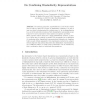Free Online Productivity Tools
i2Speak
i2Symbol
i2OCR
iTex2Img
iWeb2Print
iWeb2Shot
i2Type
iPdf2Split
iPdf2Merge
i2Bopomofo
i2Arabic
i2Style
i2Image
i2PDF
iLatex2Rtf
Sci2ools
102
Voted
MCS
2001
Springer
2001
Springer
On Combining Dissimilarity Representations
For learning purposes, representations of real world objects can be built by using the concept of dissimilarity (distance). In such a case, an object is characterized in a relative way, i.e. by its dissimilarities to a set of the selected prototypes. Such dissimilarity representations are found to be more practical for some pattern recognition problems. When experts cannot decide for a single dissimilarity measure, a number of them may be studied in parallel. We investigate two possibilities of combining either dissimilarity representations themselves or classifiers built on each of them separately. Our experiments conducted on a handwritten digit set demonstrate that when the dissimilarity representations are of different nature, a much better performance can be obtained by their combination than on individual representations.
Dissimilarity Representations | MCS 2001 | Pattern Recognition | Real World Objects | Such Dissimilarity Representations |
Related Content
| Added | 30 Jul 2010 |
| Updated | 30 Jul 2010 |
| Type | Conference |
| Year | 2001 |
| Where | MCS |
| Authors | Elzbieta Pekalska, Robert P. W. Duin |
Comments (0)

